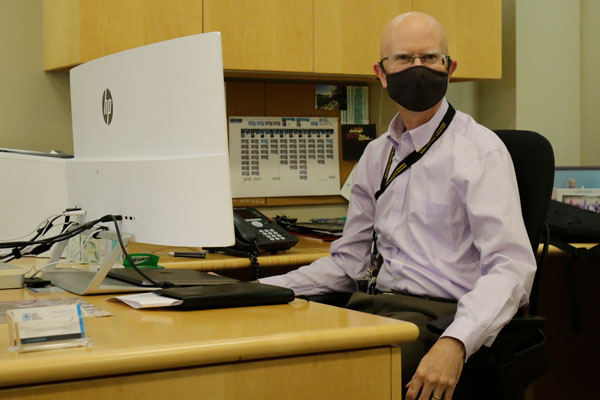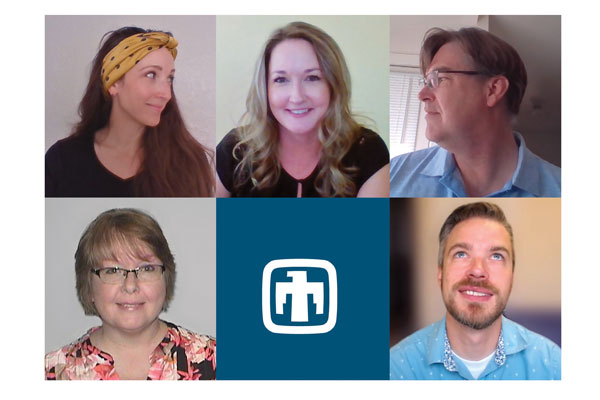Associate Labs Director Andy McIlroy reflects on how 2020 has affected Sandia

Lab News sat down for a conversation with Associate Labs Director Andy McIlroy, head of the Integrated Security Solutions Division, as he starts his second year in that role following a year permanently marked by a new reality for Sandia and the nation. Andy talked about the immense lift of suddenly having to enable everyone to work from home, space planning at the California campus in the world of social distancing and how long he expects remote work to last.
Lab News: First, thinking back to the end of 2019, what did you imagine 2020 would look like for us?
Andy McIlroy: (chuckles) You’ll have to give me a second to put myself back in that mindset. I imagined that we would be extremely busy with the weapons program — working hard on the W80-4 and charting a path to success — and that we would continue to evolve our energy programs and increase our focus on resilience and security.
At the time, I was preparing to connect with important stakeholders in Washington, D.C. I had a trip to NREL (National Renewable Energy Laboratory) planned, as well as a couple of big energy conferences on the docket — multiple opportunities in 2020 for getting Sandia’s message out in the public, especially about our energy and homeland security work. It was a really exciting plan, and it started off great!
It’s funny, but I have to add this anecdote: James Peery (Labs Director) and I spoke recently, and we both agreed that managing a pandemic response was not in the job description that either of us had applied for! (laughs) So, yes, this — what’s happened since March — was definitely not on my mind a year ago.
LN: What was your first thought about how to respond to the COVID-19 pandemic and what was most important for the division workforce at that moment?
AM: I think it was how do we keep everybody whole, in all senses of that word: how to keep people safe and how to keep paying them. We were worried about how quickly the virus was spreading. Initially, going home certainly played a large role in keeping people safe. However, in the mad scramble of that first week, we weren’t sure who could work from home or how we would pay people if they couldn’t work from home.
After realizing fairly quickly that we had enough tools to make telework happen and cover our people, we turned to the next big questions: how to keep people engaged and how to work in this new environment. I think we’re still figuring some of that out. This was all a pretty big jolt.
LN: And probably a huge lift in terms of partnering with Industrial Hygiene, Facilities, Procurement and some of the centers that were needed to do this work. Can you talk about your assessment of that effort and how safe people are on campus today?
AM: “A huge lift” is an excellent description of where we were. Because when the time came to bring people back, the big discussion among the directors and myself — and extending out to SLT (senior leadership team) — was how to do that as safely as possible. This was a very different safety question than the ones we typically work on. The problem with a virus outbreak is that the safety issues extend beyond the laboratory. So we had to define what is “safe enough.”
When discussing initial benchmarks, we thought, “Well, people have to go and buy groceries. How can we be safer than a grocery store?” That may sound a bit trivial, but we felt like we had to have some kind of benchmark. Because short of living in a completely isolated bubble with filtered air and nutrients poured into you, there really is no risk-free environment during a viral outbreak.
LN: So, what was the most important thing during these conversations?
AM: My discussions with Pam McKeever (director of California Site Operations) came down to needing two things: our security force and our custodial staff. If we can’t clean, we can’t work. At that time, only our most mission-critical personnel were on-site. But we wondered, “Can our custodians come on-site? Are they willing to come on-site?” So, we started working with Facilities to make the environment safer.
The first lift was asking Procurement to adjust our custodians’ contracts so we could pay them to come and clean more often. We then identified a need to provide cleaning supplies, hand sanitizer and personal protective equipment for those coming on-site. Procurement began looking for those relatively rare supplies, and Facilities started thinking about the logistics of storing and distributing these supplies.
Next, we tackled social distancing. After determining the optimal occupancies within buildings and labs, our Facilities staff showed us how to maintain social distancing, for example, by either reducing the number of chairs or using tape to block chairs in conference rooms. Overall, setting up the California site so that people could return to work safely was a huge lift. The New Mexico situation was a little bit more fluid but faced some of the same issues.
Then of course there was the other side: with so many people connecting from home, our IT staff had to work nonstop to provide the needed resources. Despite the hiccups we experienced early on, when I talk with colleagues at other national laboratories, I realize that Sandia’s IT experience has been much smoother than at the other labs. This says a lot about the dedication and foresight of our IT staff; they were ready and able to rise to the challenge so that we could collectively make a quick transition to working off-site.
And so it took a huge range of people to get us to where we are today — a safe environment for those who need to work on-site during this pandemic and a successful virtual experience for those who can work from home.
LN: Can you talk to us about your current priorities, given the conversations around space planning and the lease space?
AM: This goes back to your initial question. One of our big plans at the beginning of this year was how to roll out densification so that our burgeoning workforce could all fit on campus. You know, it was like bunkbeds in some of the offices. Talk about an effort totally incompatible with the pandemic!
We had to make a huge pivot on how we thought about space so we could move from densification to what I will call “rarefication” — spreading people out. And we really needed to rethink how to use the off-site lease. We quickly realized that we needed more space, not less.
The off-site lease suddenly transformed from being an opportunity to pack people in a given space to a way to spread out the fewer total people who would be coming on-site. Our facility planners did almost a complete 180 to make sure that everybody on-site will be socially distanced and in a safe place. I was really impressed with the space planning team. Even though they’d invested a lot in the densification plan, they were willing to essentially tear that plan up and start over almost overnight because they knew it was what Sandia needed.
LN: That begs the question: What do the next 12 months look like to you?
AM: Many of the issues I talked about as I started this job are still relevant. We have managed to keep good momentum on the W80-4. That continues to be a challenging program, but I’ve been impressed by the team; they have successfully innovated when confronted with significant obstacles to the schedule. I think we’re on a solid path, and I’m looking forward to the continued success of the W80-4 program as we drive into the next year.
One big challenge will be how to keep this momentum going since our virtual work environment is likely to continue for another year. At first, we thought it would be temporary — maybe four to six weeks and then perhaps eight weeks. Now that five months have passed, we’re starting to wrap our heads around the need to make our virtual environment sustainable.
We recognize that we’ll have to connect with each other remotely over a long period of time, and we absolutely must survive — and even thrive — in this environment. This means we have to continue thinking innovatively about our virtual work environments: how to selectively meet and socially distance, as well as when and how to travel. We also need to make plans so that we’re ready to come out of this stronger and better when it’s safe to do so.
The pandemic has shown us that we can adapt and overcome. We will get through this. We’ve made it this far; we’re going to make it all the way. So, it’ll be a challenging year for us, not quite the year any of us expected. But it’ll certainly be one that we tell our children about.
